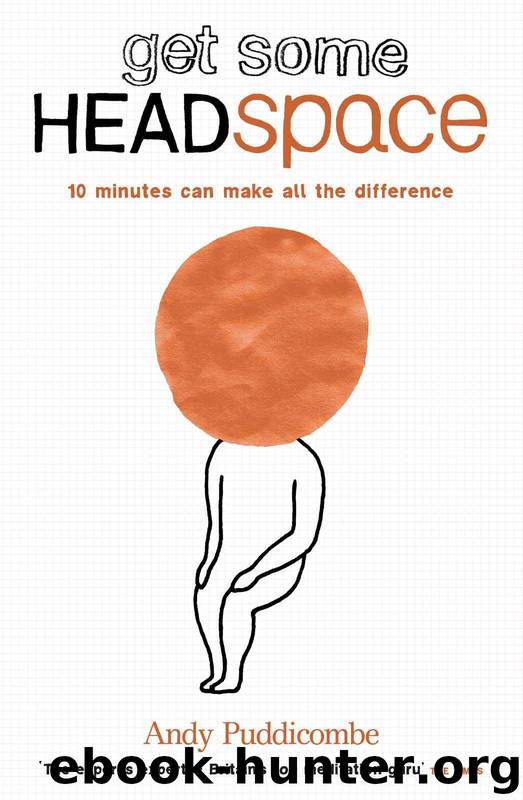Get Some Headspace: 10 minutes can make all the difference by Andy Puddicombe

Author:Andy Puddicombe [Puddicombe, Andy]
Language: eng
Format: epub, mobi
Publisher: Hodder & Stoughton
Published: 2011-05-25T23:00:00+00:00
The Integration
I’d always assumed that meditation was done sitting down with your eyes closed. So it was quite a shock when I turned up at one of my very first monasteries and was introduced not only to the cross-legged seated variety of meditation, but also to walking and standing techniques and even meditation done lying down. Now if you’re anything like me, you’ll already be thinking, ‘Oh yeah, the lying-down meditation’s the one for me!’ – though I’m sorry to say it doesn’t really work like that. Although you can still get a lot of benefit from lying down to meditate, your practice will be that much stronger if you can learn to do it sitting upright in a chair. These four types of meditation posture were not there to give us a choice as to how we’d like to meditate, but were an introduction to mindfulness. If you think back to the introduction, mindfulness simply means to be present, undistracted, in the moment, as opposed to lost in thought and caught up in the emotions. By learning how to meditate in all four postures (if you think about it, we’re always in one of them, if not in transition from one to the next), we were at the same time being taught how to be mindful in all four postures.
It may be tempting to think, ‘Yeah, but I bet the seated meditation is when the magic really starts to happen.’ So to give you some idea of how important these other postures are considered in the overall training of meditation, take the example of the daily schedule at this particular monastery.
We got up at 2.45 a.m. and started meditation at 3 a.m. We had breakfast at 5 a.m. and lunch at 11 a.m. and then one short tea-break in the afternoon. (In the tradition of this monastery, and indeed most other Buddhist monasteries, we didn’t eat after noon, so there was no break for dinner in the evening.) We finally went to bed at around 11 p.m. Now you’ve probably already done the maths, but this ensured a total of about eighteen hours of formal meditation practice every day. Of these eighteen hours, half were dedicated to walking/standing meditation, and the other half to sitting meditation, the sessions alternating one after the next. That’s how important they’re considered.
As for the horizontal meditation, alas, that was taught purely for the benefit of falling asleep (or if we were too unwell to meditate sitting upright). The idea of falling asleep in this way is that a certain amount of awareness can be maintained throughout the night if you’re lying in the correct position and maintain the right attitude of mind. In fact, there was such an emphasis placed on this, that the first question the teacher would ask me each day was ‘Did you awake on the in-breath or the out-breath this morning?’ It was a question to which at first I frequently shrugged my shoulders by means of a reply. Try it, it’s not nearly as easy as it sounds.
Download
Get Some Headspace: 10 minutes can make all the difference by Andy Puddicombe.mobi
This site does not store any files on its server. We only index and link to content provided by other sites. Please contact the content providers to delete copyright contents if any and email us, we'll remove relevant links or contents immediately.
Happiness by Matthieu Ricard(2989)
How to Stop Worrying and Start Living by Dale Carnegie(2647)
Getting Things Done by David Allen(2646)
The Chimp Paradox by Peters Dr Steve(2297)
What I Need by J. Daniels(2028)
The Empath's Survival Guide by Judith Orloff(2008)
The Finnish Way by Katja Pantzar(1933)
The Smartest Kids in the World by Amanda Ripley(1801)
Everything in Its Place by Dan Charnas(1696)
Jealousy by Osho(1696)
The Joy of Hygge by Jonny Jackson(1685)
Who Moved My Cheese?: An Amazing Way to Deal With Change in Your Work and in Your Life by Johnson Spencer(1615)
Free Yourself from Fears by Joseph O'Connor(1555)
Don't Sweat the Small Stuff at Work by Richard Carlson(1525)
How to Build Self-Discipline to Exercise by Martin Meadows(1490)
Think Happy to Stay Happy by Becca Anderson(1462)
Coping with Anxiety by Edmund Bourne & Lorna Garano(1454)
The Secret History of Freemasonry by Paul Naudon(1432)
Shook One by Charlamagne Tha God(1395)
